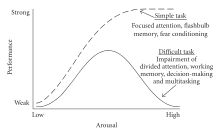Yerkes–Dodson law



The Yerkes–Dodson law is an empirical relationship between arousal and performance, originally developed by psychologists Robert M. Yerkes and John Dillingham Dodson in 1908.[1] The law dictates that performance increases with physiological or mental arousal, but only up to a point. When levels of arousal become too high, performance decreases. The process is often illustrated graphically as a bell-shaped curve which increases and then decreases with higher levels of arousal.
Levels of arousal
Research has found that different tasks require different levels of arousal for optimal performance. For example, difficult or intellectually demanding tasks may require a lower level of arousal (to facilitate concentration), whereas tasks demanding stamina or persistence may be performed better with higher levels of arousal (to increase motivation).
Because of task differences, the shape of the curve can be highly variable.[2] For simple or well-learned tasks, the relationship can be considered linear with improvements in performance as arousal increases. For complex, unfamiliar, or difficult tasks, the relationship between arousal and performance becomes inverse, with declines in performance as arousal increases.
The effect of task difficulty led to the hypothesis that the Yerkes–Dodson Law can be decomposed into two distinct factors as in a bathtub curve. The upward part of the inverted U can be thought of as the energizing effect of arousal. The downward part is caused by negative effects of arousal (or stress) on cognitive processes like attention (e.g., "tunnel vision"), memory, and problem-solving.
There has been research indicating that the correlation suggested by Yerkes and Dodson exists (such as that of Broadhurst (1959),[3] Duffy (1957),[4] and Anderson (1988) [5]), but a cause of the correlation has not yet successfully been established (Anderson, Revelle, & Lynch, 1989).[6]
Relationship to glucocorticoids
A 2007 review of the effects of stress hormones (glucocorticoids, GC) and human cognition revealed that memory performance vs. circulating levels of glucocorticoids does manifest an upside down U shaped curve and the authors noted the resemblance to the Yerkes–Dodson curve. For example, long-term potentiation (the process of forming long-term memories) is optimal when glucocorticoid levels are mildly elevated whereas significant decreases of LTP are observed after adrenalectomy (low GC state) or after exogenous glucocorticoid administration (high GC state).
This review also revealed that in order for a situation to induce a stress response, it has to be interpreted as:
- novel, and/or
- unpredictable, and/or
- not controllable by the individual, and/or
- a social evaluative threat (negative social evaluation possibly leading to social rejection).
It has also been shown that elevated levels of glucocorticoids enhance memory for emotionally arousing events but lead more often than not to poor memory for material unrelated to the source of stress/emotional arousal.[7]
See also
References
- ↑ Yerkes RM, Dodson JD (1908). "The relation of strength of stimulus to rapidity of habit-formation". Journal of Comparative Neurology and Psychology. 18: 459–482. doi:10.1002/cne.920180503.
- ↑ Diamond, David M.; Adam M. Campbell; Collin R. Park; Joshua Halonen; Phillip R. Zoladz (2007-03-28). "The Temporal Dynamics Model of Emotional Memory Processing: A Synthesis on the Neurobiological Basis of Stress-Induced Amnesia, Flashbulb and Traumatic Memories, and the Yerkes-Dodson Law". Neural Plasticity. 2007: 60803. PMC 1906714
 . PMID 17641736. doi:10.1155/2007/60803.
. PMID 17641736. doi:10.1155/2007/60803. - ↑ Broadhurst, P.L. (1956). "Emotionality and the Yerkes-Dodson Law". Journal of Experimental Psychology. 54: 345. PMID 13481281.
- ↑ Duffy, Elizabeth (1957). "The psychological significance of the concept of "arousal" or "activation"". Psychological Review. 64: 265–275.
- ↑ Anderson, KJ; W. Revelle; M.J. Lynch (1989). "Caffeine, impulsivity, and memory scanning: A comparison of two explanations for the Yerkes-Dodson Effect". Motivation and Emotion. 13: 1–20.
- ↑ Anderson KJ, Revelle W, Lynch MJ (1989). "Caffeine, impulsivity, and memory scanning: A comparison of two explanations for the Yerkes-Dodson Effect". Motivation and Emotion. 13: 1–20. doi:10.1007/bf00995541.
- ↑ Lupien SJ, Maheu F, Tu M, Fiocco A, Schramek TE (2007). "The effects of stress and stress hormones on human cognition: Implications for the field of brain and cognition". Brain and Cognition. 65: 209–237. PMID 17466428. doi:10.1016/j.bandc.2007.02.007.